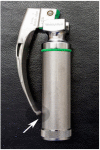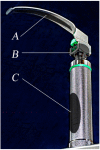Bacterial Contamination and Disinfection Status of Laryngoscopes Stored in Emergency Crash Carts
- PMID: 28605891
- PMCID: PMC5495683
- DOI: 10.3961/jpmph.17.013
Bacterial Contamination and Disinfection Status of Laryngoscopes Stored in Emergency Crash Carts
Abstract
Objectives: To identify bacterial contamination rates of laryngoscope blades and handles stored in emergency crash carts by hospital and area according to the frequency of intubation attempts.
Methods: One hundred forty-eight handles and 71 blades deemed ready for patient use from two tertiary hospitals were sampled with sterile swabs using a standardized rolling technique. Samples were considered negative (not contaminated) if no colonies were present on the blood agar plate after an 18-hour incubation period. Samples were stratified by hospital and according to the frequency of intubation attempts (10 attempts per year) using the χ2-test and Fisher exact test.
Results: One or more species of bacteria were isolated from 4 (5.6%) handle tops, 20 (28.2%) handles with knurled surfaces, and 27 (18.2%) blades. No significant differences were found in microbial contamination levels on the handle tops and blades between the two hospitals and two areas according to the frequency of intubation attempts. However, significant differences were found between the two hospitals and two areas in the level of microbial contamination on the handles with knurled surfaces (p<0.05).
Conclusions: Protocols and policies must be reviewed to standardize procedures to clean and disinfect laryngoscope blades and handles; handles should be re-designed to eliminate points of contact with the blade; and single-use, one-piece laryngoscopes should be introduced.
Keywords: Disinfection; Equipment contamination; Hospitals; South Korea; Laryngoscopes.
Conflict of interest statement
The authors have no conflicts of interest associated with the material presented in this paper.
Figures
References
-
- Hall JR. Blood contamination of anesthesia equipment and monitoring equipment. Anesth Analg. 1994;78(6):1136–1139. - PubMed
-
- Morell RC, Ririe D, James RL, Crews DA, Huffstetler K. A survey of laryngoscope contamination at a university and a community hospital. Anesthesiology. 1994;80(4):960. - PubMed
-
- Lee SO. A survey on hospital infection. J Nurs Acad Soc. 1993;23(3):325–338. (Korean)
-
- Kim JM. Current state of nosocomial infections in Korea. Korean J Med. 1999;57(4):572–577. (Korean)
-
- Cullen MM, Trail A, Robinson M, Keaney M, Chadwick PR. Serratia marcescens outbreak in a neonatal intensive care unit prompting review of decontamination of laryngoscopes. J Hosp Infect. 2005;59(1):68–70. - PubMed
Publication types
MeSH terms
LinkOut - more resources
Full Text Sources
Other Literature Sources
Medical



